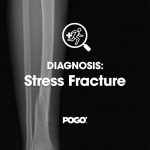Diagnosis: Sprained Ankle

Ankle sprains are a very common musculoskeletal injury that account for approximately one fourth of all sports-related injuries. The vast majority of sprained ankles occur on the lateral (outside) aspect of the ankle, and these kinds of ankle sprains are the single most frequent injury in modern sports. The most commonly injured part of the lateral ligament complex is the anterior talofibular ligament (ATFL).
How sprained ankles present
Upon observation, the ankle will typically show swelling and deformity on the side the ankle has been sprained. The patient may report a mechanism of injury such as rolling their ankle out ways during an activity or sport, with an acute onset of pain and swelling.
The ankle will typically show swelling and deformity on the side the ankle. #performbetter @pogophysio Share on XHow sprained ankles are diagnosed
After observing the site, palpation is important to reveal the maximal point of tenderness, to help decide which structures may be injured. This palpation should include the lateral and medial malleoli, the tibiotibular syndesmosis, the ATFL, the calcaneofibular ligament (CFL), and the deltoid ligament. There are many other structures that when injured can resemble an ankle sprain so these should also be palpated. These include the base of the fifth metatarsal, the calcaneus, the talus, and the peroneal tendons.
A number of specific tests are also used to test the integrity of the ligaments suspected to be damaged. The anterior drawer test looks at the ATFL, and will pick up an increase in movement in the injured side. The talar tilt test looks at the CFL and will typically show an increase in inversion ankle on the injured side if this ligament is affected.
After examination, the degree of the ankle sprain may be graded; Grade I through to Grade III. Grade I is a mild injury, with microscopic tears and stretching, Grade II involves partial macroscopic tear and Grade III is a complete tear of the ligament.
X-rays may be used to assess the potential of a fracture if there is pain reported near the medial or lateral malleolus and the patient is unable to bear weight immediately, or if there is pain in some of the other foot bones such as the navicular or base of the fifth metatarsal.
Causes of sprained ankles
Sprained ankles occur when higher than normal force or movement goes through the ligaments supporting the ankle joint. Different movements cause injury to the different structures as seen in the table below.
| Direction of movement of the ankle | Structure exposed to injury |
| Plantarflexion and inversion | Anterior talofibular ligament |
| Dorsiflexion and inversion | Calcaneofibular ligament |
| Dorsiflexion and external rotation | Syndesmosis |
| Eversion/external rotation | Medial deltoid ligament |
Treatment of sprained ankles
Treatment initially involves controlling pain and swelling. Using ice, compressive garments such as a tubi grip or bandage, and elevating the ankle above the level of the heart so to minimise swelling are all common methods. Crutches may be needed for the first 24 hours, but then the patient should commence partial weight bearing with normal walking.
Treatment initially involves controlling pain and swelling. #performbetter @pogophysio Share on XOnce pain and swelling have been controlled, rehabilitation becomes an important part of the management of ankle sprains for Grades I and II. This rehab focuses initially on increasing pain-free motion with isometric exercises to prevent loss of strength. Once full pain free motion has been established, strength is increased with exercises moving through the range of the joint, increases resistance as able. Next, proprioceptive training is important for the overall function of the ligaments and the ankle, such as balancing on one leg, and progressing the difficulty of this as relevant. The final phase of rehab focuses on sport-specific exercises to get the patient back to their desired sport and daily activities.
Grade III injuries are treated initially in a fashion similarly as above with ice, compression, and elevation. The patient may be placed in a walking boot for 3 weeks, followed by placement in a functional ankle brace for an additional 3 weeks. Rehabilitation then commences as above.
Sandi Davis
Student Physiotherapist
References
Kerkhoffs, G M. M. J, Kennedy, J. G., Calder, J. D. F., & Karlsson, J. (2016). There is no simple lateral ankle sprain. Knee Surgery, Sports Traumatology, Arthroscopy, 24(4), 941-943. doi:10.1007/s00167-016-4043-z
Klenerman, L. (1998). The management of the sprained ankle. JOURNAL OF BONE AND JOINT SURGERY-BRITISH VOLUME-, 80, 11-12.
Puffer, J. C. (2001). The sprained ankle. Clinical cornerstone, 3(5), 38-49.
Van Dijk, C. N. (2002). Management of the sprained ankle. British journal of sports medicine, 36(2), 83-84.








